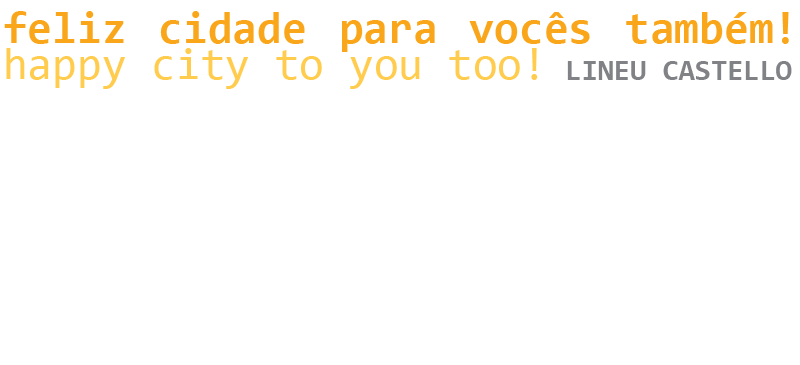
Lineu Castello é Arquiteto e Urbanista; Mestre em Design Urbano e Planejamento Regional; Doutor em Arquitetura e Professor Titular em Urbanismo. Autor dos livros Rethinking the Meaning of Place; A Percepção de Lugar e Repensando o Conceito de Lugar em Arquitetura-Urbanismo. Editor consultor da Enciclopédia da Cidade (N. York: Routledge). Ganhador do Gerd Albers Award ISOCARP. Pesquisador do CNPq e Professor-Convidado da Pós-Graduação do curso de Arquitetura da UFRGS e UniRitter/Mackenzie.
Como citar esse texto: CASTELLO, L. FELIZ CIDADE PARA VOCÊS TAMBÉM. V!RUS, São Carlos, n. 9 [online], 2013. Disponível em: <http://www.nomads.usp.br/virus/virus09/?sec=3&item=2&lang=pt>. Acesso em: 13 Jul. 2025.
Resumo
Objetivando teorizar sobre a contemporaneidade das cidades, focando-a sob a ótica do convívio – e dos lugares de convívio – entre os cidadãos, o texto contempla idiossincrasias exemplarmente representativas dos ambientes construídos contemporâneos, como: a atratividade das cidades e seu empenho pela oferta de felicidade; a polissemia sempre crescente imiscuindo o que é público com o que não é público no urbano contemporâneo; e a estruturação urbana composta por heterotopias fragmentárias que compreendem uma multiplicidade de atores. Da apreciação dessas características, de sua combinação e, principalmente, das inquietações que provocam no âmbito da curiosidade das pesquisas urbanas, o texto desenvolve ideias sobre o papel das relações interpessoais no contexto das cidades e seus resultados como geradoras de lugares de urbanidade.
1. Teorizando sobre a contemporaneidade das cidades. A metrópole contemporânea e o enfoque da estrutura urbana fragmentada
Teorizar sobre a contemporaneidade das cidades, como presentemente tentamos fazer no Laboratório no Mestrado em Arquitetura-Urbanismo, é altamente tentador. E muito – grandemente – desafiador. Sorte que um dos entendimentos atuais de metrópole fragmentada, como o de David Grahame Shane (2011), acabe atenuando um pouco essa dificuldade, ainda que a mascare por trás de uma óptica levemente roseada, empalidecendo os estragos, comumente associados à fragmentação do ambiente construído urbano. Shane discorre com destemor sobre os antecedentes da metrópole fragmentada, tanto de suas causações econômico-financeiras, quanto de hipóteses sobre suas novas configurações morfológicas arquitetônico-urbanísticas. Sobre os primeiros, lança uma interpretação bastante coerente com respeito às flutuações do capitalismo contemporâneo, quando relaciona “(...) a fragmentação urbana ao colapso do moderno sistema financeiro de Bretton Woods, baseado nos estados-nações, e sua substituição por um novo sistema de corporações globais que buscam incessantemente o lucro, mas depois enfrentam o problema de investir o que lucraram em enclaves urbanos que demonstrem confiabilidade de que preservarão esses valores.1(SHANE 2011:194). A eles, acrescenta antecedentes disparados pelo sucesso de novos empreendimentos de desenho urbano, como o Battery Park City em Nova York (de Stanton Eckstut e Alexander Cooper), muitos dos quais se fazem acompanhar pelas políticas de ‘distritos especiais’ (‘special districts’), onde, “Na Grã-Bretanha de Mrs. Thatcher e na América de Ronald Reagan, tornou-se viável a inserção de grandes fragmentos urbanos” 2(SHANE 2011:194). E quanto aos antecedentes associados a questões morfológicas, aponta como decisivo o papel representado pela publicação de obras como Collage City (ROWE and KOETTER 1978), que propunham uma configuração urbana mais livre “(...) onde múltiplos atores urbanos ficaram livres para construir seus projetos utópicos, fragmentados”3 (SHANE 2011: 203). Essas ideias acabaram endossando as libertárias visões a respeito da força de um desenho urbano fragmentário, cujos fundamentos teóricos haviam sido trazidos à luz pioneiramente por arquitetos como Kevin Lynch e Gordon Cullen. Ao se avizinharem as décadas finais do século XX já se havia definido “(...)uma nova ordem nos projetos globais de desenvolvimento, em conjunto com agências estatais independentes capazes de ajudar em ações de financiamento e projetação (empregadas, por exemplo, em Canary Wharf, Londres, Potsdamer Platz, Berlim, ou Pudong, Xangai, nos anos 1990s(...)” 4 (SHANE 2011:200). (Figuras de 1 à 4).
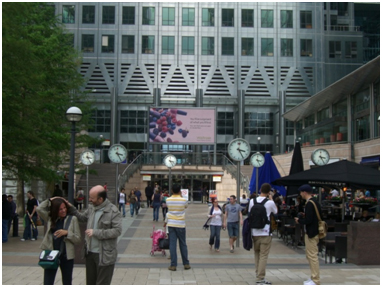
Figura 1. Canary Wharf, Londres, sofreu um revés inicial, mas agora segue em sua consolidação com decisivo vigor. Foto: Autor
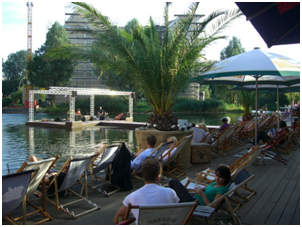
Figura 2. Berlim. Renascida dos escombros da guerra, Potsdamer Platz é agora um pujante lugar de urbanidade. Foto: Autor
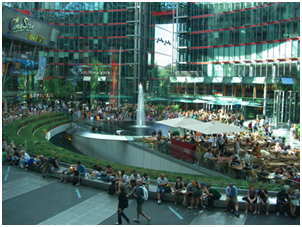
Figura 3. Berlim. O setor a cargo da Sony Corporation na PotsdamerPlatz não faz feio junto ao KulturForum modernista de sua vizinhança. Foto: Autor
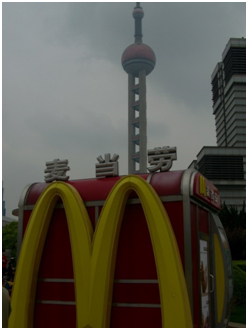
Figura 4. Do recente cultivo agrícola à exuberância das torres icônicas, o fragmento do Pudong experimenta o efeito superbonder da Mac’s em seu processo de colagem ao tecido de Xangai. Foto: Autor
É dentro de um enfoque de uma estrutura urbana assim fragmentada – enfoque que anda permeando de forma quase oportunista o raciocínio hipotético adotado no Laboratório – que se abriga uma leitura audaciosa sobre a forma da metrópole hodierna, interpretando-a através da ideia de que seus fragmentos possam remeter a representações de lugares urbanos inventados e que o efeito dos outros nesses lugares ajudem a colar os fragmentos.
Há indicadores óbvios dessa possibilidade e a maioria deles ocorre na dimensão espacial, como no caso da indiscutível aceitação pelos nova-iorquinos da inserção do Battery Park City. Existem relações com outras dimensões, é verdade, mas a maior parte delas se expressa em termos da configuração morfológica associada a fatores socioeconômicos. Desperta profundamente os interesses da pesquisa urbana, entretanto, a que talvez seja a mais crucial dessas mudanças – a da dimensão psicológica – aquela que está a afetar substancialmente a existência humana no urbano: a inconfortável sensação de estranheza a que hoje se vincula a experiência urbana. Urbanitas – denominação com que dicionários brasileiros, como Houaiss e Aurélio, já empregam para designar ‘que ou quem reside em cidade’ – estão cada vez mais sujeitos à percepção de uma estranheza a emanar do cotidiano de suas vidas nas cidades: “a tua cidade não é a minha cidade” parece ser um sentimento a escoar dramaticamente dos contatos sociais urbanos experimentados cotidianamente em nossas urbes. Óbvio, isso não é o que nossos antepassados arquitetônicos desejariam como herança das ações de Urbanismo exercitadas em épocas anteriores – e tampouco é o que colocamos como meta para o futuro dos nossos meios urbanos. Como arquitetos-urbanistas, o que podemos almejar – e desenhar, e planejar – é tentar fazer com que as cidades consigam oferecer lugares dotados de qualificações para todos, onde todos e cada um possam gozar de benefícios tanto físicos quanto psicológicos. Ou, mais coerentemente com o que permeia subliminarmente o presente texto, dotados de circunstâncias ambientais onde as pessoas possam sentir e vivenciar o significado de um lugar de urbanidade (Castello 2010), onde o convívio com os outros se torna sua essência.
2. Contribuições trazidas por outras áreas disciplinares que não da esfera de Arquitetura-Urbanismo. Variações na teoria de lugar e a atratividade das cidades
Enquanto os economistas de hoje trombeteiam sobre o ‘triunfo da cidade' (GLAESER 2011) em seus best-sellers e urbanistas nos assustam com a morte da cidade (CHOAY 1994) nas exposições que apoiam, arquitetos ironicamente nos alertam sobre o “projeto para o que costumava ser a cidade” 5 (KOOLHAAS et al 2002) e até biólogos produzem narrativas sobre um certo transurbanismo – o urbanismo da era da globalização – no qual o “(...) desafio do projeto nesse contexto é, em vez de tentar criar um único domínio público, criar uma atmosfera para o estabelecimento e coexistência de uma diversidade de domínios públicos” 6 (MULDER 2002:10). Isto porque a cidade do tal transurbanismo se materializaria por uma concatenação de variadas ‘localidades’ onde diferentes culturas ou contextos se grudariam por vias midiáticas. Com isso, será que deveremos esquecer a tradicional definição de cidade, e partir para novas ideias teóricas de desenho urbano que consigam absorver mais confortavelmente as mutações morfológicas pelas quais passa a presente 'metrópole fragmentada’? Ou, quem sabe, talvez se torne mais prudente cogitar sobre algum possível gerenciamento de uma eventual rede estruturada de lugares urbanos (Castello 2007) ou de ‘localidades’ urbanas configuradas como o que se entendia por cidade? Ou, ainda, tentar endossar padrões ditos globais de cidade, aos quais nos aludem sociólogos contemporâneos (SASSEN 2001) e que reforçam o poder de lugar no entendimento do que seja uma cidade global? Ou, enfim, em última instância, refletir sobre a necessidade de desenvolver reflexões mais elaboradas sobre o enunciado de princípios filosóficos conducentes a um Novo Urbanismo (ASCHER 2004)?
O desânimo, obviamente, não vale como alternativa escolhida.
Graças a contribuições conceituais trazidas assiduamente de outras disciplinas que não a Arquitetura-Urbanismo, já é possível perceber alguma movimentação mais animadora no sentido de elaborações a respeito de teorizar-se a contemporaneidade da cidade. E não só da cidade. É igualmente importante assinalar que nessa movimentada virada de século (e de milênio) consideráveis variações estavam do mesmo modo ocorrendo em outras conceituações também tradicionais, como, por exemplo, a de lugar, um conceito sabidamente transdisciplinar e de larga aplicação na disciplina arquitetônico-urbanística. Entre as mais notáveis variações, vale lembrar que lugar teria adquirido significados que acabaram por estender de maneira tão ampla a abrangência do conceito, que viabilizaram sua aplicação até como uma arguta metáfora para a própria cidade, dadas as inúmeras espacialidades com as quais o conceito conota. São igualmente numerosos os entendimentos acrescidos a lugar nas diversas áreas do conhecimento, a começar pelos formidáveis avanços alcançados na interpretação que a área da Filosofia dá a lugar (ver CASEY, 1998), que, ao se somarem às mudanças experimentadas pelo conceito em nossa própria área de Arquitetura-Urbanismo, fazem que nela lugar adquira uma conotação agora substancialmente existencial, além de sua mais corrente interpretação funcional (Castello 2007).
Persiste, porém, uma incômoda incógnita: como dirigir essas colaborações, tornando-as mais conformes com os fenômenos comportamentais que estão a reger a contemporaneidade de nossa sociedade?
Sempre alguma luz poderia advir do acompanhamento de posturas adotadas por cidades paradigmáticas – como Londres, Paris ou Nova York – de modo a apreciar seus movimentos, ao tentarem se consolidar como metrópoles globais, ao longo de seu constante empenho por pensar as feridas dos tecidos fragmentados.
Globais, e felizes.
Sim, porque por mais desconcertante que possa parecer nos tempos presentes, desponta nessa luta, mesmo naquelas metrópoles mais consolidadas, uma persistente busca por alguma fagulha de felicidade.
Indícios para isso existem e são suficientemente reveladores. Um deles, bastante sintomático, aliás, é levantado pela realização anual de concorridas 'International Conferences on Urban Planning and Regional Development in the Information Society’ (REAL CORP – presentemente em sua 18ª edição, a realizar-se em maio de 2013, em Roma). Ainda que essas reuniões abordem temáticas sempre desafiadoras e atuais, quando da realização do REAL CORP 2010, em Viena, foi escolhida como convocação uma discussão muito particular, em torno de uma pauta assaz estimulante: ‘cidades são atraentes!’ 7 . Intitulado ‘Cidades para todos. Habitáveis, saudáveis, prósperas. Uma visão promissora ou uma fantasia irrealística?’ 8 , o evento motivou mais de uma centena de apresentadores a debater sobre a busca por uma utópica felicidade, sob a premissa de que essa felicidade poderia ser repassada às pessoas pelas cidades.
Não estariam divagando. As ações de city marketing que cada vez mais acompanham as operações urbanas contemporâneas se tornaram tão intensas, que elas próprias já se bastariam para explicar uma busca por felicidade, carregada a reboque do planejamento das cidades de hoje. E não é para menos. O que é presentemente investido no marketing de cidades justifica plenamente a expectativa por algum tipo de retorno, no mínimo, em termos de que as cidades ofereçam algum escapismo mais consolidado, um escapismo que ajude a atenuar a realidade enfadonha do cotidiano. E é mais sintomático ainda aperceber-se que o escapismo agora se tornou correto. Humanistas clássicos como o geógrafo Yi Fu Tuan, por exemplo, notável por suas elaborações a respeito do fenômeno de ‘nós e os outros e o ambiente’, discorre sobre escapismo com surpreendente convicção em um de seus livros mais recentes, lembrando, ainda em seu preâmbulo, que “todos nós gostamos de ser especiais. Ainda que, num nível mais profundo, ser especial ou único, seja intolerável. Provoca desconexão, solidão, e vulnerabilidade. Submergir o self em um grupo para assim escapar de sua singularidade (...) é uma necessidade humana compulsória” 9 (TUAN, 1998). Não bastasse a realização da Conferência Internacional mencionada acima, convocada por instituições merecedoras de reconhecido prestígio, como CEIT (Central European Institute of Technology, Department for Urbanism, Transport, Environment and Information Society); ISOCARP (International Society of City and Regional Planners); e CORP (Competence Center of Urban and Regional Planning), nossa atual sociedade vem sendo surpreendida com rumores persistentes de que a felicidade ainda é possível. E que as cidades têm tudo a ver com essa possibilidade.
Com efeito, felicidade urbana pode não ser apenas outra utopia engendrada pelos planejadores para atrair cidadãos junto aos circuitos de venda dos corretores imobiliários. Ou vice-versa. O Royal Institute of British Architects-RIBA (Instituto Real de Arquitetos Britânicos) parece olhar seriamente para o tema, como sugere o livro ‘Building Happiness’, editado por Jane Wernick (2008) e incentivado sob encomenda daquele Instituto. O livro traz os pontos de vista de um número variado de autores e de profissionais sobre a busca da felicidade como um objetivo político determinado, e aborda o assunto com ênfase sem precedentes, oferecendo um conjunto de argumentos focados na busca da felicidade em termos de comportamentos urbanos. É interessante notar que, na maioria das discussões, a atratividade das cidades passa a ser entendida como o poder de produzir felicidade, fazendo com que essa produção passe a ser entendida como uma qualificação – o que acabaria elevando o ranking alcançado por uma cidade na concorrência com suas rivais. E concorrência, como se sabe, é o que não falta na contemporaneidade das cidades. Avanços na teorização da contemporaneidade do urbano, por outra parte, parecem concordar em um ponto: aceitar-se que a produção de lugares novos recém-inventados (ou seja, como complexos de múltiplos usos, shoppings temáticos, áreas históricas reformatadas etc.) se tornaram atores tão importantes na busca da felicidade nas cidades que, hoje, podem ser incluídos no rol de fatores que regulam o cotidiano existencial das pessoas. O filósofo suíço Alain de Botton (2007) concorda com isso e lança o livro A Arquitetura da Felicidade, onde propõe que todo o estilo arquitetônico fala de uma compreensão de felicidade. Em outras palavras, fala de como as pessoas são influenciadas de forma profunda e decisiva pela arquitetura à sua volta, seja a do lar, a do trabalho ou a das ruas. Sucesso de público e de crítica em todo o mundo por sua maneira peculiar de falar de filosofia a partir de aspectos da vida cotidiana, De Botton foca a contemporaneidade, embora sem ressaltar o papel extraordinário exercido pela presença das próprias pessoas na vivência desse novo cotidiano. Das outras pessoas. Porque não é apenas o estilo e a aparência de cada construção e dos objetos que a preenchem que afetam a sensibilidade, o humor e até mesmo a personalidade dos humanos. São as relações interpessoais que se processam nesses ambientes. Nesses ambientes de convívio. De convívio com os outros.
É juízo do presente trabalho que, caso se confirme, a tal de felicidade deverá vir necessariamente associada à presença dos outros nas cidades. Isto é, será decorrente das interações sociais, mais do que de qualquer outra causa. Interações que, na maioria absoluta das vezes, se passa em ambientes desenhados para a geração de lugares de urbanidade, como constatado no âmbito de disciplinas correlatas à nossa: “Psicologia arquitetural, psicologia ambiental, estudos pessoas/ambiente, fatores humanos de design ou ‘environics psicoestrutural’, chame-as como quiser, têm se voltado explicitamente para a criação de ambientes melhores, mais felizes e mais humanísticos” 10 (MIKELLIDES, 2008:86).
Correto, a felicidade pode ser os outros – só que o inferno também são os outros.
Se ressuscitados, Sartre confrontaria Foucault na cidade de hoje e, embora mal a tivessem conhecido com maior intimidade, demonstrariam boa familiaridade com o que se vem dizendo como teorizações sobre sua contemporaneidade. Sartre fez os personagens de Huis-Clos interagir confinados no cárcere das portas fechadas de um lugar, ressaltando a necessidade que cada indivíduo tem do ‘outro’ para o reconhecimento social que lhe permita estabelecer sua intrínseca identidade. É tentador, então, extrapolar o confinamento desse lugar ao do nosso cotidiano – ao cotidiano onde vivemos encerrados na clausura de uma cidade. Foucault, de outra parte, contempla e admira a heterotopia, entendendo-a também como o uso por diferentes grupos étnicos ou sociais de um lugar onde convergem os ‘outros’, as ‘alteridades’. Ao contrário das utopias – abstratas, puras, lógicas, verdadeiros não-espaços – as heterotopias seriam espaços reais, muito típicos do século XX, contenedores de toda uma estranha mistura de elementos díspares e de pessoas diferentes reunidas aparentemente sem lógica alguma (como em shopping malls, museus, grandes estações de transporte), mas de cuja interação, despontam eventos que “ajudaram a trazer ao mundo uma sociedade pós-moderna” 11 (SHANE 2011:346). Ou, em outros termos, passa a vicejar uma contemporaneidade notadamente mutante nas cidades: o fenômeno da criação de lugares inventados (Carmona et al. 2003), uma das marcas mais características do urbanismo dessa Pós-modernidade tão tipicamente multidisciplinar.
As heterotopias podem conter um componente revelador: a cidade deverá resistir e perseverar porque, no mínimo, os outros sempre trarão encanto para a cidade. Porque na raiz – na essência – a cidade são os outros, a cidade é heterotopia. E enquanto o ser humano continuar social, o lócus das relações interpessoais – a cidade – irá subsistir. Acaba bastante reconfortador o entendimento que Shane, alimentando-se de Foucault, nos passa sobre as atuais heterotopias urbanas, dizendo: a metrópole fragmentada de hoje seria composta por um fenômeno morfológico representado por lugares extraordinários – pelas heterotopias – que seriam “frequentemente modelos miniaturizados de uma ecologia urbana, uma pequena cidade dentro de uma cidade.” 12 A heterotopia, além disso, seria constituída por “atores múltiplos, cada um com seus próprios espaços e códigos, todos dentro de um único perímetro. (…). Atores múltiplos podendo interagir dentro de uma heterotopia, tentar novas combinações e experimentações, sem perturbar o todo da ecologia urbana”13(SHANE 2011:37-8).
3. Como o desenho urbano vem absorvendo contribuições extra-disciplinares
Não se precisa ser um especialista em estudos urbanos para perceber que as cidades de hoje experimentam uma nova tendência em termos de oferta de atratividade, tendência cada vez mais presente nas principais cidades globais, no mundo todo, e em todos os cinco continentes. Não há nada de intrinsecamente novo sobre isso, no entanto: sempre há algo a atrair as pessoas na direção de determinadas locações, pelos mais diversos e inesperados motivos.
Nunca chegou a surpreender ver levas de fiéis dirigindo-se a Lourdes, na França, por exemplo, simplesmente por que é compreensível captar sua felicidade de estar em um lugar onde um milagre uma vez foi presenciado. Da mesma forma, em tempos mais antigos, romanos afluíam ao Coliseu para assistir cristãos sendo esquartejados por leões famintos apenas pela emoção do evento (para eles, isso também era uma fonte de felicidade). Tanto Lourdes como Roma são consideradas atraentes, embora por padrões bem diferenciados. Reside aí um primeiro truísmo importante que ajuda a entender a tênue diferença entre emoção e felicidade, “emoção não sendo necessariamente igual à felicidade” 14 (SCHWARTZ, 2008:136). A atratividade das cidades, porém, tanto almeja dar emoções quanto produzir alegria, e ambas têm a ver com a busca da felicidade, um alvo frequentemente incluído dentro da ética de consumo que permeia profundamente os ideais da sociedade deste vigésimo primeiro século. Ser é ter, de acordo com os princípios de nossa sociedade. Mas, ser feliz muitas vezes se confunde com tendo algo (bem oposto ao sendo ‘heideggeriano’, por sinal). Assim, cidades competem entre si para terem atrações a oferecer aos visitantes, bem como para os moradores. Essa competitividade já se tornou reconhecida como uma área de interesse específico nos estudos urbanos, onde autores, como Simon Anholt, desenvolvem longas elaborações sobre o tema (ANHOLT 2003; 2010). Suas argumentações, basicamente, se instruem a partir da noção de marcas (‘brands’) que as cidades lutam para adquirir em seu processo de competitividade. Na verdade, competições parecem estar na ordem do dia entre as cidades de hoje, surgindo verdadeiros emblemas definidores de lugares marcantes na paisagem global. Alguns buscam, por exemplo, consagrar Paris como a cidade-luz, Nova York, como a capital cultural do mundo, ou o Rio de Janeiro, como o reino do Carnaval. Claro que nessa competição figura com destaque a oferta de alegria, isto é, as cidades tentam seduzir pessoas em termos da quantidade de felicidade que são supostamente capazes de oferecer.
Curiosamente, então, altos níveis de atratividade seriam atribuídos à força trazida pela quantidade de ‘lugares felizes’ de que são capazes de produzir. E toca ao desenho urbano a missão de cria-los. Uma das características mais marcantes reside justamente no fenômeno de que esses lugares felizes são lugares onde se reúnem muitas pessoas, ou seja, são lugares onde convivemos com os outros. Eles são o que mentalmente se constrói como um lugar de pluralidade.
São lugares plurais marcados por uma fortíssima urbanidade, qualidade poucas vezes recebedora de definições mais duradouras, mas – sempre – exclusivamente intrínseca às cidades. Em sua essência – nunca é demais lembrar – urbanidade pode ser definida como a qualificação vinculada à dinâmica das experiências existenciais conferidas às pessoas pelo uso que fazem do ambiente urbano público, através da capacidade de intercâmbio e de comunicação de que está imbuído esse ambiente.
É interessante notar a crescente preocupação que alguns autores manifestam em relação ao predomínio do sentido da visão na percepção dessas qualidades urbanas. Não é demais lembrar que há uma participação extremamente substancial da percepção tátil a conferir uma certa porosidade ao desfrute da urbanidade. Há autores, como Juhani Pallasmaa, que defendem até com veemência científica a manifestação de corporeidade na relação com os outros nas cidades, atribuindo um papel preponderante a um “(...) continuum tátil do self (...). Nosso contato com o mundo acontece na linha divisória do self através de partes especializadas de nossa membrana envolvente 15 (PALLASMAA 2012: 12). O autor reitera que “Independentemente de nossos avanços tecnológicos e das realidades virtuais, continuamos sendo biológicos – ou, melhor dizendo – bio-culturais e históricos” 16 , esclarecendo ainda que “O comportamento humano e a interação social são provocados, em essência, por espacialidades, e regulados pela utilização inconsciente do espaço que leva a uma direta comunicação química inconsciente, entre as glândulas de pessoas que se encontram próximas” 17 (PALLASMAA 2009:127).
Acresce-se a isso que o ambiente urbano público mudou – e mudou consideravelmente.
4. A polissemia do termo ‘público’ na expressão espaço público
É inquestionável que um dos tópicos de maior relevância nas discussões urbanísticas contemporâneas – melhor ainda, um dos temas que nessas discussões encontra foros para debates mais quentes – é o dos novos espaços de convívio público das cidades. A começar, pelo preciso entendimento do que venha a ser, afinal, um espaço público nos dias de hoje. Isto porque, na atualidade, dificilmente se atribuiria à expressão espaço público o mesmo sentido que lhe era atribuído em outros tempos, como por exemplo, no dos arquitetos do Urbanismo Modernista. Os espaços de acesso público nas cidades atuais incluem uma gama extremamente variada de características. François Ascher, um dos pensadores mais celebrados dos últimos tempos, precocemente desaparecido, enunciava que se está frente a uma nova maneira de perceber o que é público e o que é privado, ponderando que, em muitas situações, o caráter público de um lugar lhe é conferido pelas práticas sociais que nele são protagonizadas. Com isso, atribui o caráter público de um lugar ao fenômeno de ali se ter conformado um determinado ambiente comportamental. Diz o filósofo: “São ainda os ‘passantes’ que, por suas atividades e suas ‘interações’, dotam o espaço de seu caráter público, especialmente por suas ‘micro práticas’ feitas de movimentos, jogos e posturas corporais, orientações do olhar” (ASCHER 1995:257-8) 18 . Transparece na asserção, com bastante clareza, o entendimento de quanto é válido ponderar que a cidade são os outros.
Hannah Arendt, a filósofa germano-americana, atribuía ao espaço público a condição de ser o lugar específico aonde as pessoas (em toda sua imensa diversidade – ricos, pobres, brancos, negros etc.) poderiam (e deveriam) ser vistas e ouvidas. A atraente revisão de Arendt recentemente realizada pelo grupo de pesquisa liderado por Tom Avermaete e seu grupo de pesquisa na Delft University of Technology, Holanda, traz, de maneira inquietante, como é possível encontrar-se hoje, no trabalho de Arendt, a ideia de que esse espaço público não requer necessariamente constituir-se materialmente por uma ágora como na Grécia Antiga; ou por um fórum como na Roma Clássica; ou simplesmente, por um espaço euclidiano propriamente dito. Para Arendt, a esfera pública pode assumir muitas formas. Pode até mesmo tomar a forma de uma mídia, pode ser até uma mídia escrita, um jornal, não precisa envolver espaço – pode trazer uma enorme contribuição para a cultura local, para motivar ações, para transportar informação. Exercer urbanidade. E, assim, criar pequenos espaços públicos onde os cidadãos podem pensar juntos temas de natureza conjunta, de natureza coletiva, coisas comuns, públicas, interatuando dentro de um todo percebido como uma única ‘esfera pública’. Avermaete tem outra reflexão que traz ainda mais food for thought. Invocando Habermas, lembra que a esfera pública tem um veículo basilar nas mídias de massa (jornais, TV, livros), informando sobre ideias, demandas, protestos, meios que têm força de congregar muita gente e de habilitá-los a discutir assuntos de interesse público. Do que decorre uma inquietação nova: a Internet, ao fornecer condições para exercer funções semelhantes às das mídias de massa, também permite a geração de uma esfera pública aespacial. Hoje, mais do que nunca, o espaço de uma praça (o lugar da praça) ou o editorial de um jornal não necessitam uma locação espacial fixa. Uma multidão de pessoas pode ser mobilizada em curtíssimo espaço de tempo, numa ação que alguns já chamam de ‘flash mob crowd’ e que o grupo de holandeses, mais contidamente, denomina de ‘adhocracia’. Ponto bastante instigante a salientar é o fato de que os arquitetos continuam necessitando, quase de forma mandatória, “(...) enfrentar o desafio de moldar o espaço público – desde a piazza até a Plaza. De fato, os arquitetos se encontram buscando ativamente por respostas para essas questões, por novas formas nas quais alojar a vida pública contemporânea“19(AVERMAETE et al. 2009:19). Aonde locar o encontro com os outros.
5. Colagem de fragmentos. Heterotopias fragmentárias como fator de atratividade das cidades?
Ao fim e ao cabo, porém, parece que pelo menos um diferencial pode ser inicialmente apontado: é passível aceitar-se que mais do que nunca, a felicidade se encontra presentemente à venda nas cidades contemporâneas. Isto é uma característica bem típica (embora conscienciosamente cínica) da contemporaneidade urbana.
Com efeito, as oportunidades (e oportunismos) de pôr felicidade à venda são muito bem captadas pelos grandes produtores das cidades contemporâneas: as gigantescas corporações, que assumem como agentes finais as responsabilidades pela farta oferta de enormes – e seguros – equipamentos urbanos, permanentemente introduzidos aos cotidianos das cidades. Aos arquitetos contemporâneos resta uma das tarefas mais difíceis no processo: tentar equilibrar como se dará a oferta de felicidade dentro de um sistema proporcionalmente novo de relações entre espaço público e espaço privado. Porque permanentemente continuarão surgindo novos quesitos, alguns até impondo riscos à sadia continuidade da relação com os outros nas cidades. A jornalista inglesa Anna Minton, por exemplo, observa que os novos lugares (os invented places) se encontram cercados por tantos mecanismos de segurança que, às vezes,
Mas, mesmo assim, há perspectivas.
Enfim, é viável concluir que:
da atratividade das cidades e de seu empenho pela oferta de felicidade;
da polissemia sempre crescente a imiscuir o que é público com o que não é público, no ambiente urbano contemporâneo;
da estruturação urbana composta por heterotopias fragmentárias, compreendendo uma multiplicidade de atores;
de tudo isso combinado, brotam irresistíveis provocações à curiosidade dos pesquisadores urbanos.
Sucumbir a essa curiosidade faz elucubrar raciocínios arriscados (porém, fascinantes).
Um deles seria considerar que a cidade é tão fortemente marcada pela convivência interpessoal que as próprias interações que se desenrolam no interior das heterotopias acabarão por provocar um ‘derramamento’ de sua energia, esparramando-a para seus entornos. [E caso Julian Assange não imponha nenhum óbice nem estipule qualquer interdição, fica combinado que a denominação desse novo fenômeno passe a se chamar ‘PlaceLeaks’ (CASTELLO, 2012).
A mensagem conclusiva a passar será a de que sempre haverá lugar para novos lugares nas cidades contemporâneas, lugares cuja gênese se dá de forma relativamente espontânea e que se localizam no que vem sendo chamado de loose space – que pode ser tentativamente traduzido como ‘vazios urbanos’. A expressão é tirada do livro ‘Loose Space’ editado por Karen Franck e Quentin Stevens (2007) e, em síntese, significa aqueles espaços urbanos nos quais ocorrem usos inesperados, que diferem dos usos pré-determinados oficialmente para aquele setor da cidade (como uma calçada usada para trocas comerciais de bens e serviços; ou como um brownfield usado como área para prática de skate).
É bastante frequente encontrar-se junto às margens das espetaculares mega-intervenções de hoje em dia uma continuidade do sentido de lugar gerado pela intervenção que, por extensão, ‘contamina’ seus entornos, conferindo-lhe também animação e, quem sabe, até gerando urbanidade. Assim, o ‘vazamento’ da energia de um lugar pode se aninhar na sua interface, ocupando um ‘loose space’ vizinho.
Não é difícil imaginar uma situação dessas na realidade, como demonstram as ilustrações apresentadas a seguir (Figuras de 5 à 14). Com isso, a ideia de usar o tal de ‘PlaceLeaks’ como fonte de oferecer às pessoas um novo lugar público no repertório de lugares da cidade pode se tornar uma realização concretizável na área de Arquitetura-Urbanismo.
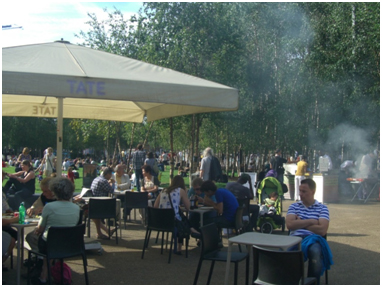
Figura 5. O museu Tate Modern em Londres, ícone da rearquitetura de velhas edificações, estende sua energia como lugar de urbanidade ao seu entorno. Foto: Autor
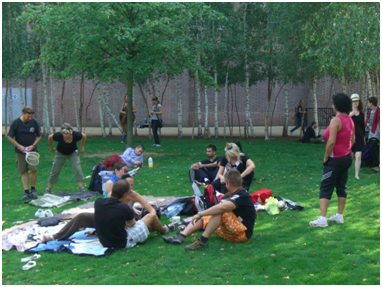
Figura 6. Um ‘loose space’ ao redor da Tate Modern, Londres, oferece um típico exemplar de PlaceLeaking. Foto: Autor
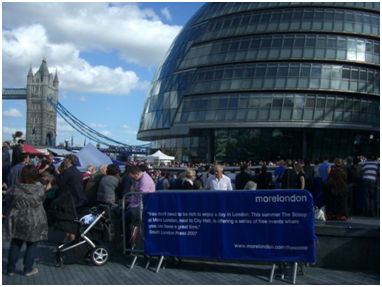
Figura 7. O icônico London City Hall é um típico lugar de encontro com os outros para quem quer desfrutar urbanidade. Foto: Autor
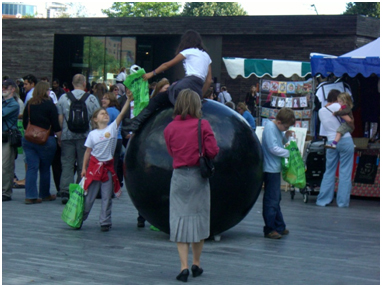
Figura 8. Mas, os arredores do London City Hall também apropriam o derramamento da energia do ícone, despertando o efeito PlaceLeaks. Foto: Autor
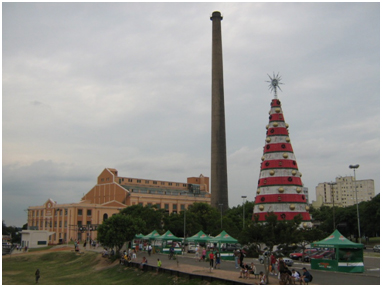
Figura 9. A Usina do Gasômetro, Porto Alegre, já é um lugar de urbanidade tão plural, que até acolhe a coletividade nas celebrações do Natal. Foto: acervo do Autor
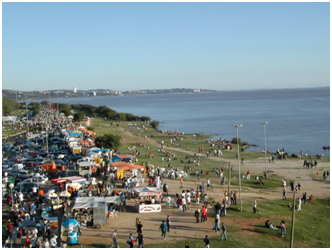
Figura 10. E a ‘energia’ (medida em urbanidade) da Usina do Gasômetro, Porto Alegre, produz um PlaceLeaking que se estende por quilômetros. Foto: Autor
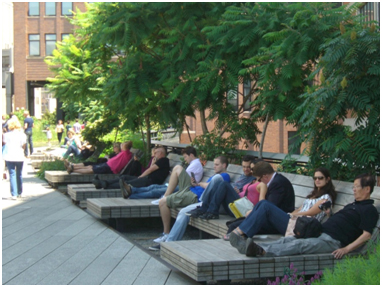
Figura 11. ‘High Line’, a nova darling dos nova-iorquinos, já se assume como um poderoso e legítimo lugar de urbanidade. Foto: Autor

Figura 12. Enquanto embaixo da ‘High Line’, numa sobra desocupada de espaço, também viceja a urbanidade, estabelecida através de PlaceLeaking. Foto: Autor
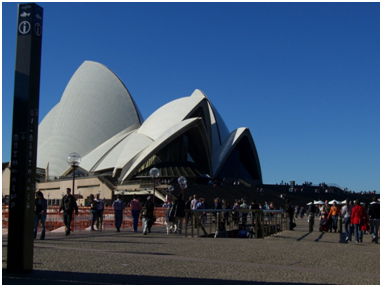
Figura 13. A Opera de Sydney é um lugar consagrado, como estamos cansados de saber. Foto: Autor
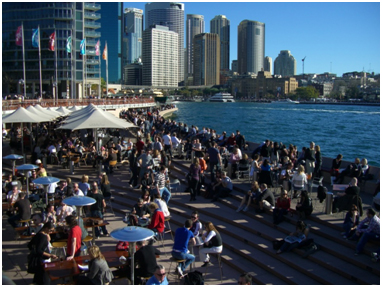
Figura 14. No entanto, o entorno da Opera de Sydney agora é também um lugar de urbanidade, resultado de um contagiante PlaceLeaking. Foto: Autor
Especula-se, então, que o emprego inteligente do fator ‘PlaceLeaks’ possa favorecer um início de resposta ao problema enfrentado pelos arquitetos, visto que estes “(…)se esforçam por buscar novas configurações aonde acomodar a vida pública, enfatizar formas já existentes aonde a vida pública continua a ter lugar, ou buscar novos modelos que tragam mudanças às práticas públicas” 21 (AVERMAETE et al. 2009:11).
Enfim, pode jazer nisso tudo até uma hipótese oculta: nas cidades dos milhões de outros é possível derramar a energia gerada pela interação com os outros, para diferentes milhões de outros situados em seus arredores, com esses outros capazes de gerar outros lugares, em seu entorno. E com as sobras de energia desses lugares, produzir uma feliz cidade para vocês também!
Referências
ANHOLT, S. Brand New Justice: The Upside of Global Branding. Oxford: Butterworth-Heinemann, 2003.
ANHOLT, S. Places: Identity, Image and Reputation. Hampshire: Palgrave Macmillan, 2010.
ASCHER, F. Métapolis ou L’Avenir des Villes. Paris : Odile Jacob, 1995.
ASCHER, F. Les Nouveaux Principes de l’Urbanisme. Paris: Éditions de l’Aube, 2004.
AVERMAETE, T.; HAVIK, K.; TEERDS, H. Architectural Positions. Architecture, Modernity and the Public Sphere. Amsterdam: SUN Publishers, 2009.
CARMONA, M. et al. Public Places - Urban Spaces. Oxford: Architectural Press, 2003.
CASEY, E. S. The Fate of Place. A philosophical story. Berkeley: University of California Press, 1998.
CASTELLO, L. A Percepção de Lugar. Repensando o conceito de lugar em arquitetura-urbanismo. Porto Alegre: PROPAR/UFRGS, 2007.
CASTELLO, L. PlaceLeaks: a passage to place. In Bulletin of People-Environment Studies, No.38 Spring 2012 p.43-4.
CASTELLO, L. Rethinking the Meaning of Place. Conceiving place in architecture-urbanism. Farnham: Ashgate, 2010.
CHOAY, F. Le regne de l’urbain et la mort de la ville. Catalogue of the exhibition: La Ville. Art et Architecture. Paris: Centre George Pompidou, 1994, p.26-35.
De BOTTON, A. A Arquitetura da Felicidade. Trad.: Talita Rodrigues. Rio de Janeiro: Rocco, 2007.
FRANK, K. and STEVENS, Q. (eds.). Loose Space. Possibility and diversity in urban life. Londres/Nova York: Routledge, 2007.
GLAESER, E. Triumph of the City. How our greatest invention makes us richer, smarter, greener, healthier, and happier. Nova York: Penguin Press, 2011.
KOOLHAAS, R. et al. (eds.). The Harvard Design School Guide to Shopping. Cologne: Taschen, 2002.
MIKELLIDES, B. The Love Affair between Psychology and Architecture. In J. Wernick (ed.). Building Happiness. Londres: Black Dog, 2008, p.86-97.
MINTON, A. Ground Control. Fear and happiness in the twenty-first century city. Londres: Penguin Group, 2009.
PALLASMAA, J. Inhabiting Space and Time – the Loss and Recovery of Public Space. In Tom Avermaete et al. (eds.) 2009, op. cit., p.125-133.
PALLASMAA, J. The Eyes of the Skin. Architecture and the senses. 3rd edition. Chichester: Wiley, 2012.
SASSEN, S. The Global City, in Rem Koolhaas et al. Mutations. Bordeaux: ACTAR, 2001, p.104-115.
SCHWARTZ, M. Happiness in the Landscape. In J. Wernick (ed.). Building Happiness. Londres: Black Dog, 2008, p.134-139.
SHANE, D. G. Urban Design Since 1945. A Global Perspective. Chichester: Wiley & Sons, 2011.
TUAN, Y. Escapism. Baltimore, Maryland: The Johns Hopkins University Press, 1998.
WERNICK, J. (ed.). Building Happiness. Architecture to Make You Smile. Londres: Black Dog, 2008.
1“(…) the urban fragmentation to the collapse of the modern Bretton Woods financial system based on nation states, and its replacement by a new system of global corporations that relentlessly sought profits but then had the problem of investing that profit in safe, urban enclaves to preserve its value.”
2“In Mrs Thatcher’s Britain and Ronald Reagan’s America, huge urban fragments became feasible.”
3“(…) where multiple urban actors were free to build their fragmentary, utopian designs.”
4“(...) the new norm of global development, along with independent state authorities that could aid development and finance (used, for instance, at Canary Wharf, London, Potsdamer Platz, Berlin or Pudong, Shanghai in the 1990s(…).”
5“(...) the project for what used to be the city.” (Título da famosa obra da equipe de Rem Koolhaas, The Harvard Design School Guide to Shopping).
6“(…) design challenge in this context is, instead of trying to create a single public domain, to create an atmosphere for the establishment and coexistence of a diversity of public domains.”
7“Cities are attractive!”
8Cities for Everyone. Livable, healthy, prosperous. Promising vision or unrealistic fantasy?”
9“We all like to be special. Yet at a deep level, being special or unique is intolerable It makes for disconnectedness, loneliness, and vulnerability. Submerging the self in a group, thus escaping from one´s singularity, frailty, and openness to change, is a compelling human need.”
10“Architectural psychology, environmental psychology, people/environment studies, human factors of design or psychostructural environics, call what you may, has been concerned explicitly in making better, happier and more humane environments.”
11“(...) have helped bring a postmodern society into the world.”
12“(...) often miniature models of an urban ecology, a small city within a city.”
13“(…) multiple actors, each with their own spaces and codes, all within one perimeter. (…). Multiple actors could interact inside the heterotopia, try new combinations and experiment, without disturbing the whole urban ecology.”
14“(...) thrill not necessarily equaling happiness (...)”
15“(…) haptic continuum of the self (…). Our contact with the world takes place at the boundary line of the self through specialised parts of our enveloping membrane.”
16“Regardless of our advanced technologies, digital communication, and virtual realities, we continue to be biological – or I should rather say – bio-cultural and historical beings.”
17“Human behaviour and social interaction are essentially spatially triggered and regulated from the unconscious utilization of space to the direct unconscious chemical communication between the glands of persons at close distances.”
18Ce sont aussi les ‘passants’ qui, par leurs activités et leurs ‘interactions’, dotent l’espace de son caractère public notamment par des ‘micro-pratiques’ faites de mouvements, de jeux et de postures du corps, d’orientations du regard.
19“(...) face the challenge of shaping public space – from piazza to Plaza. Indeed, architects are actively searching for answers to these questions, for new forms in which to house contemporary public life.”
20“(...) there are psychological dangers as well in creating places which have too much security and as a result are too safe and too controlled. The problem is that these environments remove personal responsibility, undermining our relationship with the surrounding environment and with each other and removing the continual, almost subliminal interaction with strangers which is part of healthy city life.”
21“(…) strive towards new figures in which to accommodate public life, emphasize existing forms in which public life continues to take place, or search for new approaches to changing public practices.”
Lineu Castello is an Architect and Urbanist; M.Phil.in Urban Design-Regional Planning; Ph.D. in Architecture; Urbanism Professor. Author of books Rethinking the Meaning of Place; A Percepção de Lugar and Repensando o Conceito de Lugar em Arquitetura-Urbanismo; Consultant Editor of the Encyclopedia of the City (N. York: Routledge). Winner of the Gerd Albers Award ISOCARP. CNPq Researcher/ Brazil and Guest Professor of the Graduate Course of Architecture at UFRGS and UniRitter/Mackenzie.
How to quote this text: CASTELLO, L. HAPPY CITY TO YOU TOO. V!RUS, São Carlos, n. 9 [online], 2013. [online] Available at: <http://www.nomads.usp.br/virus/virus09/?sec=3&item=2&lang=en>. [Accessed: 13 July 2025].
Abstract
Aimed at theorizing about the contemporaneity of cities and focusing on them from the perspective of coexistence — and places for coexistence — among citizens, this article addresses idiosyncrasies that exemplarily represent contemporary built environments, e.g., the attractiveness of cities and their provision of happiness, the ever-increasing polysemy intermingling that which is public with that which is non-public in contemporary urban space, and the urban structuration composed of fragmentary heterotopies encompassing a multitude of actors. From the appraisal of these characteristics, their combination, and especially the concerns engendered among urban researchers, this article addresses the role of interpersonal relationships in the context of the city and their outcomes as generators of places of urbanity.
1. Theorizing about the contemporaneity of cities. Contemporary metropolises and the focus on fragmented urban structure
Theorizing about contemporary cities, as presently attempted at the Architecture-Urbanism Graduate Program Lab the Author is connected to in Uniritter/Mackenzie Universities, is highly appealing and greatly challenging. Fortunately, one of the current interpretations for the fragmented metropolis, as that advanced by David Grahame Shane (2011), ends up slightly mitigating this difficulty, albeit concealed behind a slightly rosy screen, thus lessening the damage commonly associated with fragmentation of urban built environments. Shane daringly writes about the background of the fragmented metropolis, its economic and financial causes as well as hypotheses about new morphological architectural-urban settings. As regards the former, he provides an interpretation quite consistent with fluctuations of contemporary capitalism when he associates “[…] urban fragmentation to the collapse of the modern financial system of Bretton Woods, based on nation-states, and its replacement with a new system for global profit-seeking corporations, which then face the problem of investing their profits in urban enclaves demonstrating reliability that they preserve these values” (Shane, 2011:194). To them, he adds background issues triggered by the success of new ventures in urban design, e.g., Battery Park City in New York (Stanton Eckstut and Alexander Cooper), many of which are accompanied by ‘special district’ policies, where, “in Mrs. Thatcher’s Britain and in Ronald Reagan’s America, it became possible to insert large urban fragments” (Shane, 2011:194). In addition, as regards the background issues associated with morphological issues, he considers the decisive role played by the publishing of studies, e.g., Collage City (Rowe & Koetter, 1978), proposing a new, more free urban configuration “[…] where multiple urban actors were free to build their fragmentary, utopian designs” (Shane, 2011:203). These ideas ended up endorsing libertarian views on the power of a fragmentary urban design, whose theoretical foundations had been brought up by pioneer architects such as Kevin Lynch and Gordon Cullen. The end of the twentieth century had brought about “[…] the new norm of global development, along with independent state authorities able to aid development and finance (used, for instance, at Canary Wharf, London, Potsdamer Platz, Berlin or Pudong, Shanghai in the 1990s) […]” (Shane, 2011:200) (Figures 1-4).

Figure 1. Canary Wharf, London, suffered a setback in the beginning, but now is firmly on consolidation course. Photo: Author

Figure 2. Berlin. Reborn from the rubble of war, Potsdamer Platz is now a thriving place of urbanity. Photo: Author

Figure 3. Berlin. The sector under the auspices of Sony Corporation at Potsdamer Platz does not make a bad impression before the modernist KulturForum ensemble in its vicinity. Photo: Author.

Figure 4. From formerly cultivated fields to the exuberance of iconic towers, Pudong fragment experiences Mac’s superglue effect in the process of joining Shanghai’s urban fabric. Photo: Author.
It is this perspective of a fragmented urban structure that permeates, almost opportunistically, the hypothetical reasoning adopted at the Lab, which harbors a bold interpretation of today’s metropolises form, i.e., in light of the concept that its fragments may allude to representations of invented urban places and the assumption that the effect of other on them can help to patch the fragments together.
There is clear indication of this possibility and most of it takes place on the spatial dimension as is the case of New Yorkers’ unquestionable acceptance of Battery Park City. It is true that it is associated to other dimensions as well, but most of them are expressed in terms of morphological configurations linked to socioeconomic factors. Of great importance to urban research, however, the most vital change, related to the psychological dimension, is that which is substantively affecting human existence in urban spaces: the uncomfortable feeling of oddness permeating today’s urban experience. Urbanites — a word now defined as ‘those which or who reside in a city’ — are increasingly more subject to the perception of oddness deriving from their everyday lives in cities: “your city is not my city” seems to sum up a feeling that dramatically resonates from urban social contact experienced in our cities on a daily basis. Obviously, this legacy is not what bygone architects and city planners wished to be the result of past urban interventions. Nor is it our goal for cities of the future. Qua architects and urban designers, we can only hope — and design and plan — is try to provide places for cities endowed with qualities that meet everyone’s needs, where each and every one of us can benefit from them both physically and psychologically. Or, more consistent with what permeates this text subliminally, endowed with environmental circumstances in which people can feel and experience the meaning of a place of urbanity (Castello, 2010), where its very essence lies in coexisting with others.
2. Contributions of disciplines outside of the field of architecture and urbanism. Variations in the theory of place and the attractiveness of cities
While contemporary economists brag about the ‘triumph of the city’ (Glaeser, 2011) and urban designers herald its doom (Choay, 1994), architects ironically advise us about “[…] the project for what used to be the city” (Koolhass et al., 2002) and even biologists come up with narratives about some type of transurbanism, a globalization-era urbanism, in which the “[…] design challenge in this context is, instead of trying to create a single public domain, to create an atmosphere for the establishment and coexistence of a diversity of public domains” (Mulder, 2002:10). This is due to the fact the ‘transurbanism’ city would emerge from the concatenation of various ‘locations,’ where different cultures and contexts would come together via the media. Based on that, shouldn’t we cast the traditional definition of city aside and pursue new urban design theories that can more readily absorb morphological mutations undergone by today’s ‘fragmented metropolises’? Or, perhaps, wouldn’t it be wiser to think up ways to manage a possible structured network of urban places (Castello, 2007) or urban ‘localities’ shaped after what a city was formerly understood to be? Or, yet, shouldn’t we try to endorse so-called global standards for the city, to which some contemporary sociologists allude (Sassen, 2001) and which emphasize the power of place in understanding what a global city is? Or, ultimately, shouldn’t we reflect on the need to conceive more elaborate philosophical principles conducive to a New Urbanism (Ascher, 2004)?
Dismay is obviously not a valid alternative.
Thanks to conceptual contributions from disciplines other than Architecture and Urbanism, it is possible to see a promising movement towards more elaborate theorizations with regard to the contemporary city. And not just about the city. In this eventful turn of the century (and millennium), it is also important to note that considerable variations have occurred simultaneously in other traditional concepts, e.g., the concept of place, a concept widely applied in the field of Architecture and Urbanism and known to be transdisciplinary. Amongst noteworthy variations, place acquired meanings that resulted in a broader and ampler concept, which has enabled its use even as a keen metaphor for the city itself, given the countless number of spatialities it implies. Likewise, there are countless interpretations for the concept of place originated in different fields of knowledge, e.g., the formidable advancement achieved by the field of Philosophy in its understanding of place (see Casey, 1998), which, together with the changes it has undergone in the field of Architecture and Urbanism proper, gives the concept a new essentially existential connotation beyond its current functional understanding (Castello, 2007).
There remains, however, an uncomfortable unknown: how to manage these collaborations more in line with the behavioral phenomena governing our contemporary society?
Some understanding could derive from tracking paradigmatic stances adopted by major cities, e.g., London, Paris or New York, in order to appreciate their movements as they try to secure their status of global metropolises, along with their constant effort to take the sores of their fragmented fabrics into account.
Global and happy.
Yes, because, as disconcerting as it may seem now, a persistent search for some spark of happiness emerges from this struggle, even in those more established cities.
Evidence for this exist and is sufficiently revealing, an incidental example of which can be found in the crowds that gather at the annual International Conferences on Urban Planning and Regional Development in the Information Society (REAL CORP, currently in its 18th edition, to be held in May 2013 in Rome). Although these meetings always address challenging current issues, REAL CORP 2010, in Vienna, was chosen to convene a rather specific discussion on the topic Cities are attractive! Dubbed as Cities for All, Livable, Healthy, Prosperous, Promising vision or unrealistic fantasy?, the event encouraged more than a hundred presenters to debate the search for a utopian happiness, under the premise that cities can pass this happiness on to their inhabitants.
They are not digressing. City marketing actions that increasingly accompany contemporary urban operations have become so powerful that they themselves are already enough to vindicate the search for happiness, in tow of today’s city planning. And for a good reason. What is presently invested in marketing cities fully justifies the expectation for some kind of return, at least in terms of a more consolidated kind of escapism that cities can provide, a kind of escapism that helps alleviate the dull reality of everyday life. And it’s even more emblematic to note that escapism itself has now become acceptable. The geographer Yi Fu Tuan, who has outstandingly theorized about the phenomenon of ‘us and the others and the environment,’ in the vein of classical humanist approaches, writes about escapism with surprising conviction in one of his latest books, reminding us in its preamble that “We all like to be special. Yet at a deep level, being special or unique is intolerable. It makes for disconnectedness, loneliness, and vulnerability. Submerging the self in a group, thus escaping from one’s singularity, frailty, and openness to change, is a compelling human need” (Tuan, 1998, p.x).
Moreover, the above mentioned international conference, sponsored by prestigious institutions such as CEIT (Central European Institute of Technology, Department for Urbanism, Transport, Environment and Information Society); ISOCARP (International Society of City and Regional Planners) and CORP (Competence Center of Urban and Regional Planning); are also contributing to persistent rumors that happiness is still possible in our present societies and that cities have much to offer to its accomplishment.
Indeed, urban happiness cannot be just another utopia engendered by planners, alongside real estate brokers’ sales channels, to attract citizens. Or the other way around. RIBA (Royal Institute of British Architects) seems to be seriously looking into this issue, as suggested by the book ‘Building Happiness,’ edited by Jane Wernick (2008) and commissioned by this institute. The book brings the views of a varied number of authors and professionals on the pursuit of happiness as a specific political goal and approaches the subject with unprecedented emphasis, providing a set of arguments anchored in the pursuit of happiness in terms of urban behaviors. Interestingly, in most discussions, city attractiveness is interpreted as its power to create happiness, which favors the understanding of the production of the city as a qualification and eventually raises the ranking of a city in competition with rivals. And competition, we all know, is not absent in contemporary cities. Advances in contemporary city theory, on the other hand, seem to agree on one point: accepting that the production of new, newly invented places (e.g., multiple-use complexes, themed shopping malls, and reformatted historical areas) has become so important to the pursuit of happiness in the city that it may be nowadays included on the list of factors that regulate city dwellers’ everyday existence.
Swiss philosopher Alain de Botton (2007) agrees with that and released the book The Architecture of Happiness, which propounds that every architectural style speaks of an idea of happiness. In other words, he writes about how people are profoundly and decisively influenced by the architecture around them, whether at home, work or on the streets. A best-seller around the world due to his peculiar way of addressing philosophical points based on facets of everyday life, De Botton focuses on contemporaneity, albeit without mentioning the extraordinary role played by the presence of people themselves in experiencing this new routine. Of the others. Because the style and look of all buildings and objects that fill it are not the sole factors affecting people’s sensitivity, humor or even personality. There are other factors such as interpersonal relationships within these environments. Environments of coexistence. Coexistence with the others.
It is herein understood that, if confirmed, this happiness should come necessarily associated with the presence of the others in the city. That is, it will be the result of social interactions, more than anything else. Interactions that happen, most of the time, in environments intended for generating places of urbanity, as found within the scope of disciplines related to ours: “Architectural psychology, environmental psychology, people/environment studies, human factors of design or psychostructural environics, call what you may, has been concerned explicitly in making better, happier and more humane environments” (Mikellides, 2008:86).
Right, happiness can be the others, but hell is also the others.
If resurrected, Sartre would confront Foucault in today’s metropolises, and although they could not have known them more intimately, they would display some understanding of the aforementioned theorizing about its contemporaneity. Sartre made the characters of Huis-Clos interact confined to the prison space of a closed-doors space, stressing the need every individual has for ‘the other’ to achieve the kind of social recognition that allows them to establish their intrinsic identity. It is tempting, then, to extend the confinement of this place to our daily lives, the everyday lives we live locked in the cloisters of a city. On the other hand, Foucault addresses and admires heterotopia, defining it as the use by different ethnic or social groups of a place where ‘the others’ or ‘alterities’ converge. Unlike abstract, pure, logical utopias, true non-spaces, heterotopias are real spaces, very typical of the twentieth century, receptacles of a strange mixture of disparate elements and different people apparently gathered for no reason at all (as at shopping malls, museums, major transport stations), from whose interaction, events that “[…] have helped bring a postmodern society into the world” emerge (Shane, 2011:346). Or, in other words, a notably mutant contemporaneity comes about in the cities: the phenomenon of creating invented places (Carmona et al., 2003), one of the most visible characteristics of urbanism resulting from this typically multidisciplinary postmodernity.
Heterotopias can contain a revealing component: the city must endure and persevere because at least the others will always bring charm to the city. Because at its root, in its essence, the city is composed of the others; the city is a heterotopia. And as long as humans remain social, the locus of interpersonal relationships, i.e., the city will endure. Shane’s viewpoint is quite reassuring when he writes about current urban heterotopias, based on Foucault, i.e., that today’s fragmented metropolises consist of a morphological phenomenon represented by extraordinary places, by heterotopias, defined as “[…] often miniature models of an urban ecology, a small city within a city.” Moreover, heterotopias could be described as comprising “[…] multiple actors, each with their own spaces and codes, all within one perimeter. […] Multiple actors could interact inside the heterotopia, try new combinations and experiment, without disturbing the whole urban ecology” (Shane, 2011:37-8).
3. How urban design has absorbed extra-disciplinary contributions
One does not have to be an expert in urban studies to notice that today’s cities are experiencing a new trend in terms of supply of attractiveness; an increasingly visible supply in metropolises worldwide. There is nothing intrinsically new about that, though; there will always be something that attracts people to some places for the most unexpected and diverse reasons.
It should come as no surprise to see hundreds of faithful pilgrims flocking to Lourdes, France, for example, simply because it is possible to capture their happiness for being at a place where a miracle was allegedly witnessed. Likewise, in older times, Romans flocked to the Coliseum to watch Christians being butchered by hungry lions just for the thrill of it (that was also a source of happiness to them). Both Lourdes and Rome are considered attractive, albeit due to very different standards. Therein lies the first important truism that sheds light on the subtle difference between emotion and happiness, “[…] thrill not necessarily equaling happiness […]” (Schwartz, 2008:136). The attractiveness of cities, however, craves to foster emotions as well as to promote joy, and both have to do with the pursuit of happiness, a target often included within the ethics of consumption that deeply permeates twenty-first century societies’ ideals. To be is to have according to our society’s principles. But being happy is often confused with having something (which, by the way, is quite different from Heidegger’s being). Thus, cities compete to have attractions to offer visitors and locals alike. This competition has been recognized as of specific interest to urban studies, in which authors, such as Simon Anholt, develop long arguments on this topic (Anholt 2003; 2010). Their arguments basically rely on the notion of brands, which cities struggle to acquire in the course of competing with one another. Actually, competition seems to be on the agenda of today’s cities, giving rise to true emblems defining extraordinary places in the global landscape. Some seek, let's say, to mark Paris out as the City of Light, New York as the Cultural Capital of the World, or Rio de Janeiro as the City of Carnival. Evidently, the supply of joy prevails in this competition, that is, cities try to lure people in terms of the level of happiness they are supposedly capable of providing.
Interestingly therefore, high levels of attractiveness are attributed to the amount of ‘happy places’ they are capable of producing. And it is up to urban designers to create them. One of the most remarkable characteristics lies precisely in the fact that these happy places are places where many people gather, i.e., places where we live with others. They are that which can be construed as a place of plurality,
They are plural places laden with urbanity, a feature seldom worthy of long-lasting definitions, but — always — utterly intrinsic to cities. It is never too late to remember that urbanity can be essentially defined as the qualification associated with the dynamics of existential experiences made possible by people’s use of public urban environments, through their inherent capacity for reciprocity and communication.
It is interesting to note the growing concern voiced by some authors with respect to the predominance of the sense of vision in perceiving these urban qualities. It is worth remembering that the participation of tactile perception in imparting some porosity to the enjoyment of urbanity is very substantial. Some authors, such as Juhani Pallasmaa, argue vehemently for the manifestation of corporeality concerning the others in the city, assigning a key role to a “[…] haptic continuum of the self […]. Our contact with the world takes place at the boundary line of the self through specialized parts of our enveloping membrane” (Pallasmaa, 2012:12). Pallasmaa claims that “regardless of our advanced technologies, digital communication, and virtual realities, we continue to be biological – or I should rather say – bio-cultural and historical beings,” and affirms that “human behaviour and social interaction are essentially spatially triggered and regulated from the unconscious utilization of space to the direct unconscious chemical communication between the glands of persons at close distances” (Pallasmaa, 2009:127).
In addition to that, the public urban environment has changed — and considerably so.
4. The polysemy of the term ‘public’ in the expression public space
Undeniably, one of the most relevant topics in contemporary discussions about urbanism, or better, one of the themes in these discussions that engender the hottest debates, is the new public living spaces of cities. It should begin with the understanding of what precisely constitutes a public space these days. This is because, nowadays, seldom is the expression public space attributed the same meaning that was once assigned to it, for example, by the Modernist Urbanism architects. Public-access spaces in is private, considering that in many situations the public character of a place is conferred on it by social practices that happen in it. Along these lines, he attributes the public character of a place to the phenomenon of a particular behavioral environment having occurred there. Ascher claims that “It is still the ‘bystanders’ who, by means of their activities and their ‘interactions,’ endow the space with a public character, especially because of their ‘micro-practices’ composed of movements, body postures and play, directions of gazes” 1 (Ascher, 1995:257-8). The legitimacy of considering the city as composed of the others is quite clear in this assertion.
Hannah Arendt, the German-American philosopher, attributed to the public space the condition of being the specific place where people (in all its diversity: rich, poor, white, black, etc.) could (and must) be seen and heard. The compelling review of Arendt’s work recently conducted by the research group led by Tom Avermaete at Delft University of Technology, Netherlands, brings forth, in a disturbing way, how it is possible today to find in Arendt’s work the idea that this public space does not necessarily constitute a physical agora as it did in Ancient Greece, a forum in Imperial Rome or even a Euclidean space. For Arendt, the public sphere can take many forms. It can even take the form of a communication medium; it can be a written medium, a newspaper; it need not involve space; it can bring a huge contribution to local culture, to motivate action, to impart information. To exercise urbanity. And, thus, to create small public spaces where citizens can think together about issues of a shared, collective nature, common issues, public issues, interacting within a whole perceived as a single ‘public sphere’. Avermaete brings more food for thought. Invoking Habermas, the author reminds us that mass media is the basic vehicle in the public sphere (newspapers, TV, books), reporting on ideas, demands, protests; the media have the power to bring many people together and empower them to discuss issues of public interest. That can be very disquieting: the Internet, by providing people with the means to perform duties similar to those of the mass media, also allows the emergence of a non-spatial public sphere. Today, more than ever, the space of a square, or the editorial in a newspaper, does not require a fixed spatial location. A crowd can be mobilized in a very short time, an action that some have dubbed ‘flash mob crowd’ and that the Dutch research group more prudently calls ‘adhocracy.’ A very exciting point worthy of note is the fact that architects continue to need, almost mandatorily, “[…] to face the challenge of shaping public space – from piazza to Plaza. Indeed, architects are actively searching for answers to these questions, for new forms in which to house contemporary public life” (Avermaete et al., 2009:19). Where to locate the meeting with the others.
5. Gluing fragments together. Fragmentary heterotopia as an element of city attractiveness?
At the end of the day, however, it seems that at least one difference may be pointed: it is possible to accept, more than ever, that happiness is presently for sale in contemporary cities. This is a very typical feature (albeit conscientiously cynical) of urban contemporaneity.
Indeed, opportunities (and opportunism) for putting happiness on sale are superbly seized by large producers of contemporary cities: giant corporations that ultimately take up responsibility for the abundant supply of large — and safe — urban facilities, implanted in cities’ routines for good. To contemporary architects, there remains one of the most difficult tasks in the process: to try to keep the supply of happiness in place within a relatively new system of relationships between public spaces and private spaces. Because new requirements will continue to emerge, some even imposing risks to the continuity of a mutually beneficial relationship with the others in cities. For instance, the English journalist Anna Minton notes that new places (invented places) are surrounded by many security mechanisms that sometimes,
Nevertheless, there are good prospects.
Finally, it is possible to conclude that:
the attractiveness of cities and their commitment to supply happiness;
the ever-increasing polysemy interspersing what is public with what is not in contemporary urban environments;
the urban structure composed of fragmentary heterotopias, comprising a multitude of actors;
all this combined seductively incite urban researchers’ curiosity.
Succumbing to this curiosity causes one to perform some risky (but fascinating) reasoning.
One of them is to think that the city is so strongly marked by interpersonal coexistence that the very interactions that take place within heterotopias eventually cause its energy to ‘spill out,’ spreading it over its surroundings. (And if Julian Assange does not impose any impediment nor stipulate any ban, it is agreed herein that this new phenomenon be referred to as ‘PlaceLeaks’.)(Castello, 2012).
The concluding message is that there will always be room for new places in contemporary cities, places whose genesis occurs rather spontaneously and which are located in what is now called loose space (tentatively translated as ‘urban voids).’ This expression was taken from the book “Loose Space” edited by Karen Franck and Quentin Stevens (2007), which, in a nutshell, refers to urban spaces where unexpected uses occur, uses that differ from those officially pre-determined for that sector of the city (such as using a sidewalk to trade in goods and services or a brownfield used as a skating spot).
It is quite common to find at the margins of today’s spectacular mega-interventions a continuity of the sense of place generated by the intervention, which in turn ‘contaminates’ its surroundings, providing it with liveliness and, perhaps, even urbanity. Thus, the energy ‘leakage’ from a given place can nestle on its interface, occupying a neighboring ‘loose space.’
It is not hard to imagine such a situation in real life, as shown by the pictures below (Figures 5-14). In this light, the idea of employing ‘PlaceLeaks’ as a source of new public places in the city’s existing repertoire of places may become feasible in the field of Architecture and Urbanism.

Figure 5. Tate Modern in London, icon of old building re-architecture, spreads its energy as a place of urbanity over its surroundings. Photo: Author.

Figure 6. A ‘loose space’ around Tate Modern in London, a typical example of PlaceLeaking. Photo: Author.

Figure 7. Iconic London City Hall is a typical place for meeting the others for people who crave for urbanity. Photo: Author.

Figure 8. The vicinity of London City Hall also takes advantage of the energy leaking from this iconic building, giving rise to the PlaceLeaks effect. Photo: Author.

Figure 9. Usina do Gasômetro in Porto Alegre is such a plural place of urbanity that it even welcomes the community for Christmas celebrations. Photo: Author.

Figure 10. The ‘energy’ (measured in urbanity) of Usina do Gasômetro in Porto Alegre gives rise to a PlaceLeaking effect that extends for kilometers. Photo: Author.

Figure 11. High Line, New Yorkers’ new darling, is already a powerful and legitimate place of urbanity. Photo: Author.

Figure 12. Whereas underneath High Line, in a vacant stretch of space, urbanity also thrives, established through PlaceLeaking. Photo: Author.

Figure 13. Sydney Opera House is a distinguished place, as we all know. Photo: Author.

Figure 14. Notwithstanding, Sydney Opera House’s surroundings are also a place of urbanity, due to contagious PlaceLeaking. Photo: Author.
There is speculation, then, that the intelligent use of ‘PlaceLeaking’ may favor an early response to the problem faced by architects, since they “[…] strive towards new figures in which to accommodate public life, emphasize existing forms in which public life continues to take place, or search for new approaches to changing public practices” (Avermaete et al., 2009:11).
Lastly, there may be a hidden assumption in all that: in the city of a million others, it is possible to spread the energy generated by the interaction with the others to another million others located in their vicinity, with these others capable of generating other places around them. And with the surplus energy from all these places, producing felicity for you too!
References
ANHOLT, S., 2003. Brand New Justice: The Upside of Global Branding. Oxford: Butterworth-Heinemann.
ANHOLT, S., 2010. Places: Identity, Image and Reputation. Hampshire: Palgrave Macmillan.
ASCHER, F., 1995. Métapolis ou L’Avenir des Villes. Paris : Odile Jacob.
ASCHER, F., 2004. Les Nouveaux Principes de l’Urbanisme. Paris: Éditions de l’Aube.
AVERMAETE, T.; HAVIK, K.; TEERDS, H., 2009. Architectural Positions. Architecture, Modernity and the Public Sphere. Amsterdam: SUN Publishers.
CARMONA, M. et al., 2003 Public Places - Urban Spaces. Oxford: Architectural Press.
CASEY, E. S., 1998. The Fate of Place. A philosophical story. Berkeley: University of California Press.
CASTELLO, L., 2007. A Percepção de Lugar. Repensando o conceito de lugar em arquitetura-urbanismo. Porto Alegre: PROPAR/UFRGS.
CASTELLO, L., 2012. PlaceLeaks: a passage to place. In Bulletin of People-Environment Studies, No.38, p.43-4.
CASTELLO, L., 2010. Rethinking the Meaning of Place. Conceiving place in architecture-urbanism. Farnham: Ashgate.
CHOAY, F., 1994. Le regne de l’urbain et la mort de la ville. Catalogue of the exhibition: La Ville. Art et Architecture. Paris: Centre George Pompidou, p.26-35.
De BOTTON, A., 2007. A Arquitetura da Felicidade. Trad.: Talita Rodrigues. Rio de Janeiro: Rocco.
FRANK, K. and STEVENS, Q. (eds.), 2007. Loose Space. Possibility and diversity in urban life. Londres/Nova York: Routledge.
GLAESER, E., 2011. Triumph of the City. How our greatest invention makes us richer, smarter, greener, healthier, and happier. Nova York: Penguin Press.
KOOLHAAS, R. et al. (eds.), 2002.The Harvard Design School Guide to Shopping. Cologne: Taschen.
MIKELLIDES, B., 2008. The Love Affair between Psychology and Architecture. In J. Wernick (ed.). Building Happiness. Londres: Black Dog, p.86-97.
MINTON, A., 2009. Ground Control. Fear and happiness in the twenty-first century city. Londres: Penguin Group.
PALLASMAA, J., 2009. Inhabiting Space and Time – the Loss and Recovery of Public Space. In Tom Avermaete et al. (eds.), op. cit., p.125-133.
PALLASMAA, J., 2012. The Eyes of the Skin. Architecture and the senses. 3rd edition. Chichester: Wiley.
SASSEN, S., 2001. The Global City, in Rem Koolhaas et al. Mutations. Bordeaux: ACTAR, p.104-115.
SCHWARTZ, M., 2008. Happiness in the Landscape. In J. Wernick (ed.). Building Happiness. Londres: Black Dog, p.134-139.
SHANE, D. G., 2011. Urban Design Since 1945.A Global Perspective. Chichester: Wiley & Sons.
TUAN, Y., 1998. Escapism. Baltimore, Maryland: The Johns Hopkins University Press.
WERNICK, J. (ed.), 2008. Building Happiness. Architecture to Make You Smile. Londres: Black Dog.
1“Ce sont aussi les ‘passants’ qui, par leurs activités et leurs ‘interactions’, dotent l’espace
de son caractère public notamment par des ‘micro-pratiques’ faites de mouvements, de jeux
et de postures du corps, d’orientations du regard”.

